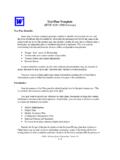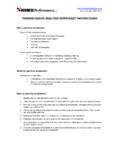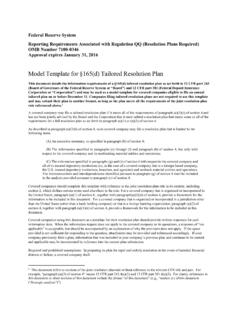Transcription of Water and Wastewater System Emergency Response Plan …
1 Kentucky Rural Water Association 3251 Spring Hollow Ave. Bowling Green, KY 42104 Phone: (270) 843-2291 Fax: (270) 796-8623 Water and Wastewater System Emergency Response plan Template This template is designed to be a guide for Emergency Response Planning. It is not an all inclusive document. July 2003 Emergency Response planning should be a coordinated and planned process. Proper planning canlessen the impact of an Emergency . All staff should be trained as to their responsibility within the planand how it will be implemented. This template was designed to address various Emergency hazards thatmay occur in rural and small systems. It incorporates emergencies that may be the result of of the type of Emergency whether natural or man-made each System has the responsibility tobe prepared to protect the public health and to restore services that may be plan should incorporate information from the Security Vulnerability Self-Assessment.
2 Assistance isavailable from your State Rural Water the process of planning may vary depending on the size of your System it is suggested that thefollowing steps be utilized in the planning process:Step I Prepare a Governing Body/Staff Briefing - A briefing should be prepared to acquaint theGoverning Body/Staff with risks and vulnerabilities to their Utility. Also a part of this step is to make someestimate of what personnel resources will be required to assist in the planning effort and for what lengthsof 2 Obtain Management Commitment - Obtain from the Governing Body a commitment to allocatethe appropriate resources and personnel to the planning effort. A mission statement should be obtainedto provide direction for the 3 Form a Coordinating Committee - This committee will be a working group and will develop adetailed work program and schedule.
3 A list of assumptions should be prepared by this committee withthe goal to establish a set of minimum standards for the 4 Assign the Planning Responsibilities - This task will help to identify individuals that will have aspecific responsibility during the planning effort. One person should be designated as EmergencyDirector for the Utility and should assume the lead in plan preparation and 5 Document Procedures - Document the administrative procedures to account for and managethe planning process, including plan development and plan to Use this TemplateThis document is designed for use by Water System personnel. There are three sections to first part provides instructions and process for completion of the planning process. The second partis the Emergency Response plan and the third part is miscellaneous and resource this DocumentThis is a working document.
4 Its purpose is to start your process of Emergency Response planning. Itshould be reviewed and updated on a regular scheduled basis. Don t forget this is a sensitive should be stored separately in a secure to this document should be limited to key Water System personnel and local officials andothers on a need-to-know :The foundation of this template is the Rural and Small System Emergency Response Manual, which wasdeveloped in 1994 in Response to, increased man-made and natural disasters. The manual wasdeveloped through Georgia Rural Water Association with input from a host of state and federal PageIntroduction I-1 Instructions for completion of templateI-2 I-5 Certification Letter Template and Law LanguageI-6 Template ContentsGeneral Information1 plan Goals 2 Classification of Emergency 3 critical Information for Emergency Response Management4 & 4aImmediate Actions and Procedures to Lessen5 Impact of Identified EmergencyCommunication Log6 Contact List 7-12 Work Order Log 13 Location of critical Information 14 Recovery Checklist15 Preliminary Damage Assessment 16 plan Distribution List17 Record of Changes 18 Emergency Hazard Identification Ranking Form 19
5 critical Components and Vulnerabilities 20 plan Evaluation21 Mitigation/Prevention Possibilities 22 Miscellaneous InformationUtility Mutual Agreement Sample 24-25 Flood Debris 26 Solid Waste Handling 27 Household Chemicals 28 Disinfections of Unsafe Drinking Water 29-31 Water Pollution 31 Septic Tanks 31 Underground Storage Tank 32 Wastewater Treatment Plans 33 Trapped Flood Water 33 Dealing with the Media 37 Instruction for Completion of Template:These instructions are not provided in numerical page order. They are designed so that if the instructionsare followed, the completed plan will be in a logical sequence for ease of use if there is an Complete page 4 critical InformationThis form provides critical information that will be immediately needed in case of an Emergency .
6 Itdefines general information about the System and 1st priority contact information. The designated officialsto manage the Emergency should be involved in the planning stage of this plan . In any Emergency thenews media will be involved. It is important to designate one individual as the spokesperson. Additionalresource material on dealing with the media is provided on page Complete page 2 Establishment of GoalsA System is considered a lifeline because Water and Wastewater is essential to the safety and health ofthe population it serves. Each System service area should develop specific goals and acceptable levels ofservice under hazards and recovery conditions. Establish a state of goal for each essential area. If thereis more than one goal they should be prioritized to provide direction for the planning process andresponse to an Emergency .
7 The following are specific goals to Safety - A System s primary goal should be to preserve the health and safety of its personnel and thepublic. Meeting this goal should be considered a continuous function of the System before, during andafter the effects of a hazard are experienced. Examples of life-threatening or injury-causing conditionscould be: Failure of distribution System Failure of dams Distribution of contaminated Water Release of hazardous materials, especially chlorine Collapse of structures such as Water towersFire Suppression - Most fire suppression activities depend on the potable Water distribution disasters, there may be many fires to fight. Fire suppression capabilities should be made availableimmediately after a disaster, or as soon as Health Needs - Water is essential to life and health.
8 However, some needs are more immediatethan others. The following list is of public health needs and the allowable time without potable Water beingavailable. Times are guidelines only and depend on the magnitude of the disaster. Hospitals Continuous need Emergency Shelters Immediate need Kidney Dialysis 24 hours Drinking Water 72 hours Personal Hygiene, Waste Disposal 72 hoursCommercial Business Uses - Many businesses depend on Water for their operation; for example,restaurants, car washes and many manufacturing companies. However, nearly all businesses could notfunction for long without potable Water for drinking, waste disposal and cooling Water for air conditioningand other process systems. Also, many commercial structures are protected with fire sprinkling systemsthat should not be left without a Water priorities for service is an important part of completing this step of vulnerability analysis.
9 Mostmedical facilities need continuous service; contact them to determine approximate daily needs orestimate their needs from utility records. Other priorities should be police and fire departments, and theI - 1emergency operations center. For medical facilities and other priority customers, it is a good idea to havea record of a contact person or persons, their phone numbers, reasons for needing priority service,approximate daily needs and an alternative on-site source if one is Requirements - Water requirements under disaster conditions can be assumed or estimated onlyin terms of the nature and magnitude of the disaster, user needs and capabilities of the System . Anattempt to approximate Water demand for each type of hazard should be made using whatever localexpertise is available.
10 Research conducted by state and federal agencies may provide useful informationby drawing on the expertise from like Complete pages 7, 8 , 9 , 10, 11 and 12 Emergency Response ContactsThese pages contain names and contact information that may be needed during an Emergency . Oncethe plan is completed this listing should be reviewed to ensure that all available resources that may beneeded are Complete page 19 Emergency Hazard Identification and RankingThis form is designed to identify the types of emergencies the System may be subject to. Although it maybe a guess, an effort must also be made to predict the probability of a disaster or Emergency for yourservice identifying the type of Emergency , determine the probability of it occurring and if it did the most likelymagnitude of the event on your final step on this form is to rank each Emergency hazard.







